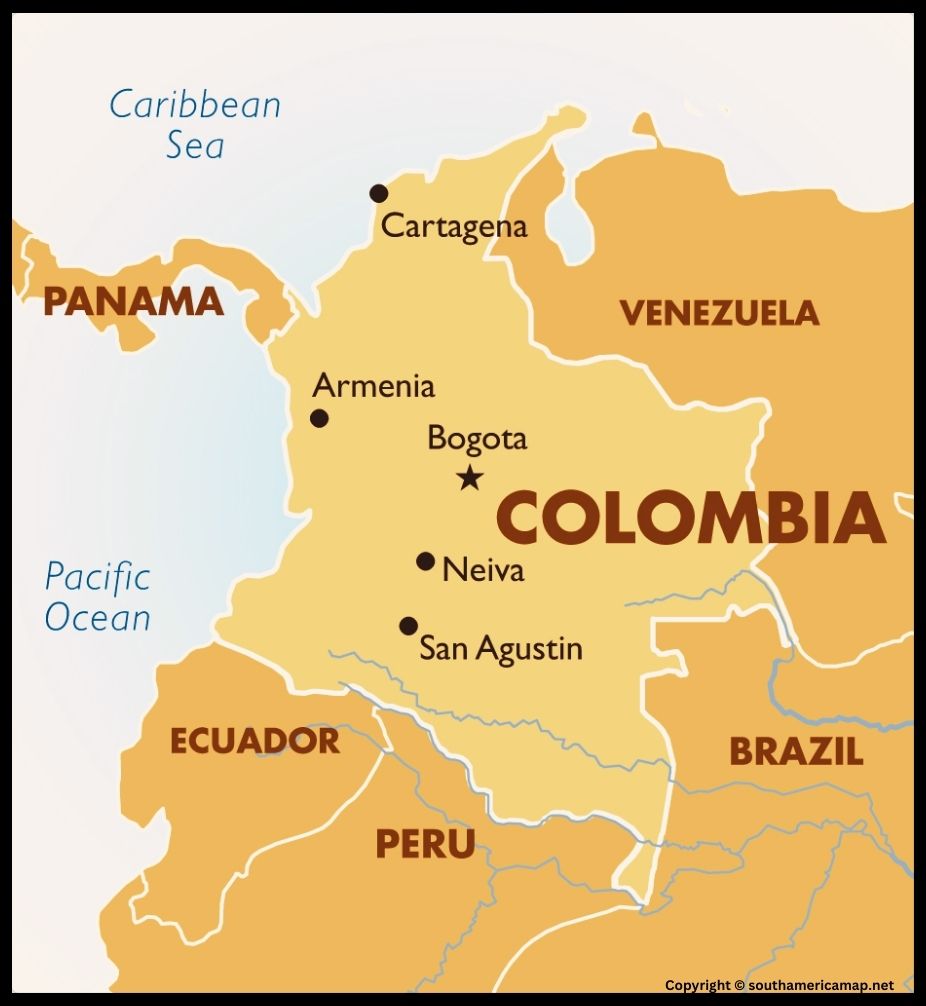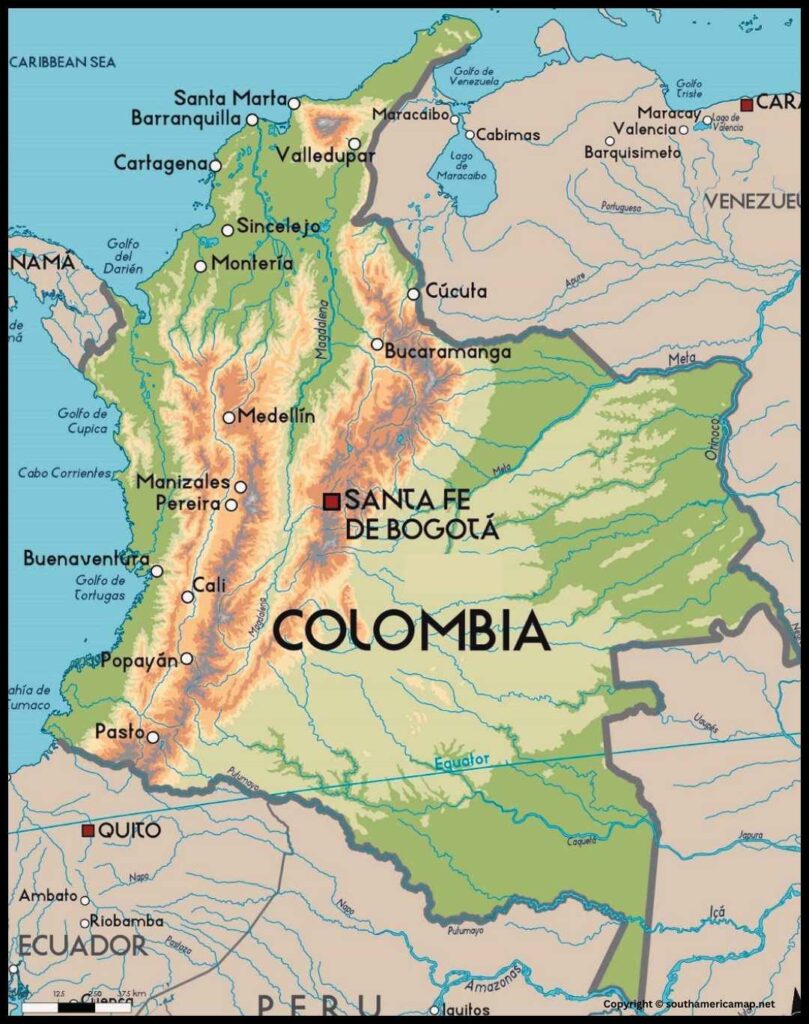Map of Colombia South America – Colombia, located in the northwestern region of South America, is a country of captivating geographical diversity and historical significance. Bordered by Venezuela to the east, Brazil to the southeast, Peru to the south, Ecuador and Panama to the west, and the Caribbean Sea to the north, Colombia boasts a strategic and unique position on the continent.
The country’s topography is marked by the towering Andes mountain range, which runs through its western spine, shaping the landscape and providing breathtaking vistas. To the east, the expansive Amazon rainforest contributes to Colombia’s rich biodiversity. The northern coast is bathed by the warm waters of the Caribbean Sea, while the western shoreline faces the Pacific Ocean.
Colombia’s equatorial location ensures a tropical climate with distinct wet and dry seasons, fostering lush ecosystems and supporting the nation’s agricultural output. Beyond its natural wonders, Colombia’s location has played a pivotal role in its cultural and economic connections, making it a dynamic crossroads in South America.
Related Post –
Map of Colombia South America [Columbia South America Map]
A map of Colombia in South America is a valuable resource for individuals interested in exploring, understanding, and appreciating this diverse and vibrant country. It offers a range of benefits, including:
1. Education:
- Visualizing Colombia’s geography: A labeled map provides a clear and concise representation of Colombia’s location within South America, its borders, major cities, physical features (Andes Mountains, Amazon rainforest, Caribbean coast, etc.), and bodies of water (Magdalena River, Pacific Ocean, etc.). This visual representation enhances learning about Colombia’s geography and its diverse landscapes.
- Understanding the relationships between different regions: Labels on the map help connect cities, regions, and physical features, fostering a better understanding of Colombia’s internal geography and how different parts of the country interact.
- Facilitating research and exploration: A map can be a starting point for research projects on specific regions, historical sites, or natural wonders of Colombia. Students and researchers can use the map to locate places of interest, research their history and culture, and plan real-world or virtual explorations.
2. Navigation:
- Planning travel routes: Whether planning a trekking adventure in the Sierra Nevada de Santa Marta, a cultural exploration of Cartagena, or a visit to the Amazon rainforest, a detailed map of Colombia is essential for plotting routes, identifying landmarks, and navigating unfamiliar terrain.
- Understanding distances and transportation networks: Labels on the map indicate distances between cities and towns, as well as major roads, railways, and waterways. This information helps plan efficient travel itineraries and understand the logistics of moving around the country.
- Finding specific locations: With labels identifying cities, towns, national parks, and natural wonders, a map allows travelers to easily locate specific destinations and navigate with confidence.
3. Cultural appreciation:
- Learning about diverse cultures and languages: Colombia is a multicultural country with a rich tapestry of indigenous communities, Afro-Colombian populations, and regional traditions. A labeled map can help identify areas with distinct cultures and languages, fostering a deeper understanding of the country’s diverse heritage.
- Understanding the political and historical context: Labels on the map can highlight historical sites, colonial cities, and battlefields, providing context for understanding Colombia’s political history and cultural evolution.
- Appreciating the natural wonders: Labels identifying Los Nevados National Park, the Coffee Triangle, and the Tatacoa Desert inspire curiosity and appreciation for Colombia’s unique ecosystems and biodiversity.
4. Economic development:
- Planning infrastructure projects: Maps are crucial for planning and executing infrastructure projects like carreteras, railways, bridges, and pipelines, which are essential for economic development and connecting different regions within Colombia.
- Identifying resources and potential investments: A map can help identify areas rich in natural resources, such as oil, minerals, and agricultural land, prompting potential investments and economic growth.
- Promoting tourism: Detailed maps can be used to create informative tourist materials, highlighting key attractions, travel routes, and cultural experiences, attracting visitors to Colombia and boosting the tourism industry.
Map of Colombia South America Cities
Environmental protection:
- Monitoring environmental changes: Maps can be used to track deforestation, desertification, and other environmental threats, aiding in conservation efforts and protecting Colombia’s natural resources.
- Planning sustainable development projects: Maps help identify areas suitable for sustainable development projects like renewable energy installations, eco-tourism initiatives, and sustainable agriculture, which can protect the environment while promoting economic growth.
- Raising awareness of environmental issues: By visually representing environmental issues like deforestation and pollution, maps can raise public awareness and encourage action towards environmental protection.
Overall, a map of Colombia in South America is more than just a geographical representation; it is a valuable template for education, navigation, cultural appreciation, economic development, and environmental protection. By understanding the diverse benefits of using a map, individuals can gain a deeper understanding of Colombia’s geography, history, culture, and its place within South America.
![Map of Colombia South America [Columbia South America Map]](https://southamericamap.net/wordpress/wp-content/uploads/2023/12/Map-of-Colombia-South-America-with-Cities-in-Printable-Pdf-min-933x1024.jpg)

